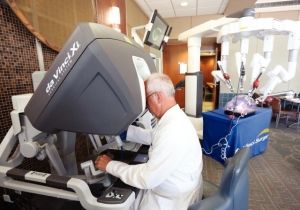Da Vinci surgery -- next generation
By Phyllis Moore
Published in News on June 30, 2015 1:46 PM

News-Argus/MELISSA KEY
Dr. Brent Ellmers, general surgeon, tests out the latest da Vinci Xi robot by completing a computer exercise. Ellmers already uses a version of the machine to perform minimally invasive surgeries such as those on the galbladder. Wayne Memorial Hospital hopes to purchase the latest da Vinci Xi robot in the near future.

The latest version of the da Vinci Xi robot has 360 degree control that allows for nuanced control while performing minimally invasive surgeries such as those on the gallbladder.
Dr. Brent Ellmers positions himself behind a console, wrapping his fingers around the controls and focuses on the screen before him that projects an image of the patient he will perform surgery on across the room.
That's right, across the room from him.
Through modern technology, the da Vinci robot features instruments controlled by a surgeon from a console with 360-degree capability, allowing for more intricate maneuvers and is used for minimally invasive procedures.
Wayne Memorial Hospital acquired the da Vinci surgery equipment in 2009.
Since then, it has been used on such procedures as gallbladder surgery as well as such urologic and gynecologic surgeries as prostatectomies and hysterectomies.
"Right now, we're doing robotic surgeries on gall bladder, hernias and hiatal hernia repairs for reflux and some other gynecological cases, also," said Dr. Ellmers, a general surgeon with Wayne Health Surgical Associates.
Laproscopic surgery produces better outcomes -- because it is less invasive, recovery time can also be shorter, the doctor said.
Recently, the latest model of the da Vinci, the Xi, which just hit the market in January, was on display in the hospital cafeteria, allowing physicians to take a "test drive."
Dr. Ellmers said the advancement could allow the hospital to expand the number and types of surgeries it is currently performing.
The fourth-generation version of the robot -- the hospital currently has the second-generation model -- comes with a $2 million price tag. Officials at the hospital have not committed to the purchase.
"They're being a little coy with me," Dr. Ellmers said. "We're negotiating when we can get it in."
Georgia Dees, public relations director at the hospital, said the hospital is currently configuring its budget for the coming year and it is "unclear" as to whether, or when, the new robotic system might be part of it.
Dr. Ellmers said he has been pleased with the system already in place at the hospital, but admitted the newer model had some impressive bells and whistles.
For example, the Xi can "port-hop," to see different angles, while also featuring better detail and visibility. It also allows single-site access, or "single-port access," he added, which boils down to only needing to make one incision.
"The picture is even better than the 3-D picture that we get now," he said. "It does expand what we're able to do. I'm really excited about this."
The hospital currently only has one da Vinci, which was why on the day the Xi made its stop in Goldsboro, Dr. Ellmers had additional time -- he was waiting for another physician to finish robotic surgery so he could use it.
There is extensive training involved to use the intricate equipment. Only a handful at the hospital are experienced on it.
"In general surgery right now I'm the only general surgeon trained on the robotic," Dr. Ellmers said. "For ob/gyn I think we have six that are robotic-trained -- (Dr. John) Welsh, (Dr. Greg) Nichols, (Dr. Peter) Roethling, (Dr. Joseph) Flynn, (Dr. Robert) Thiele, and (Dr. Glen) Nowacheck."
The advanced technology has been embraced not only by the physicians, but their patients.
"It's not that hard, I really don't have to sell it," Dr. Ellmers said. "Most patients are very trusting, if I tell them it's the best way to do things.
"A lot of them are pretty excited when they hear it's robotics."
